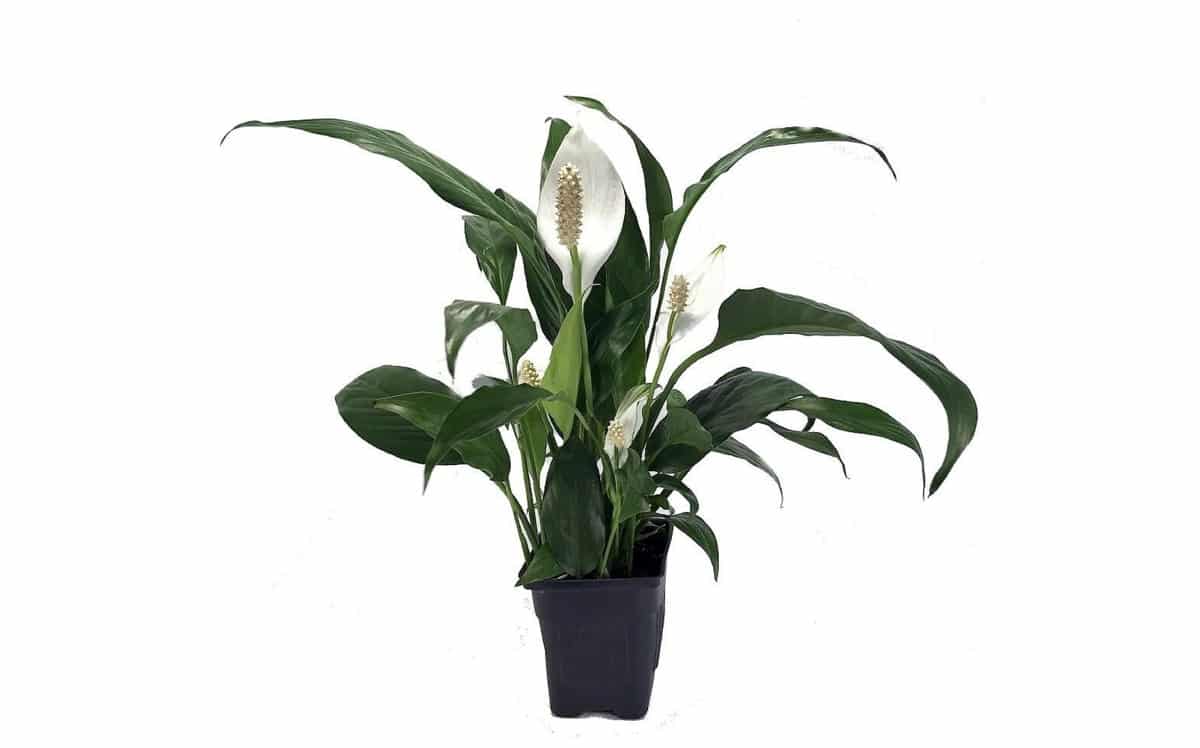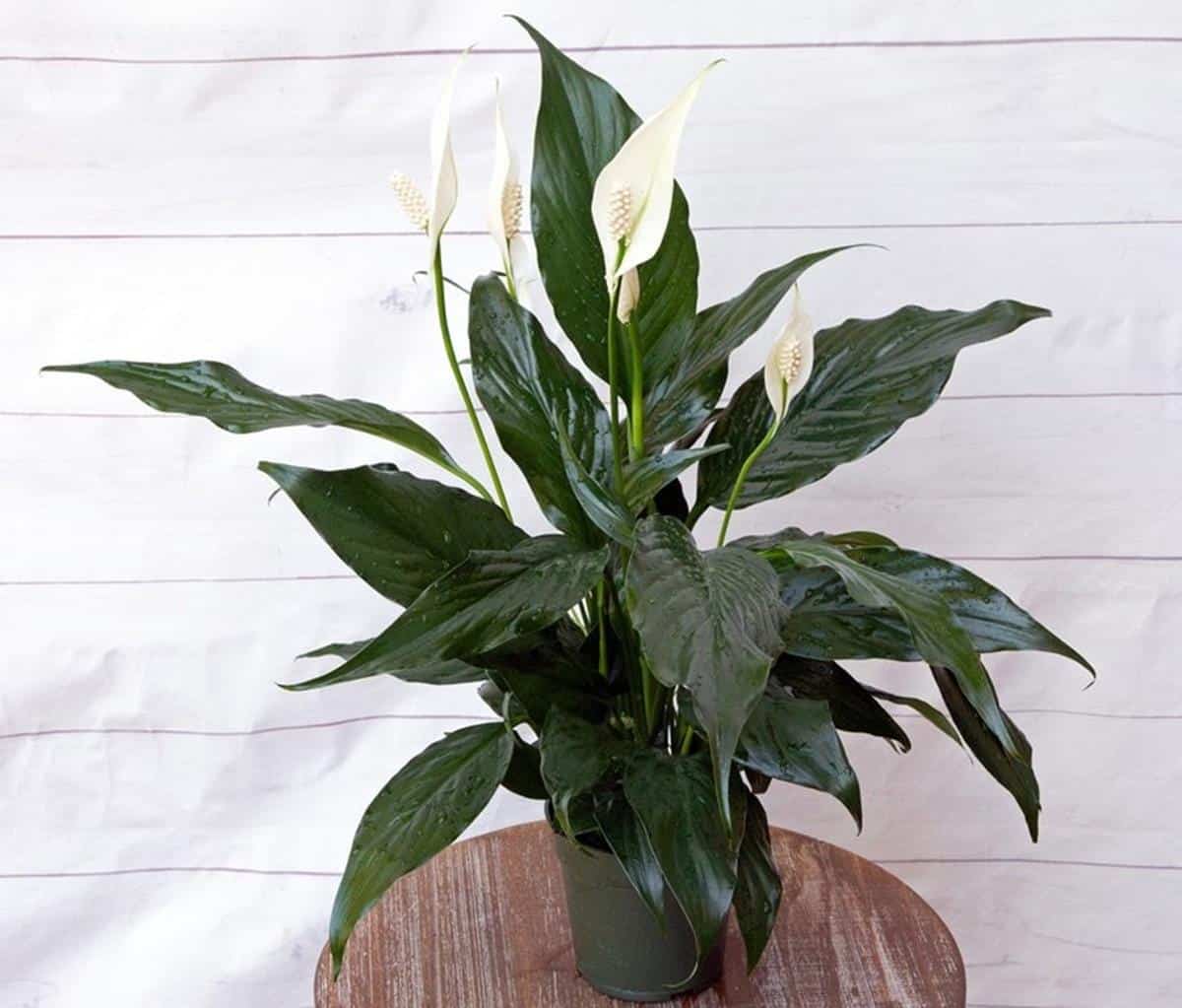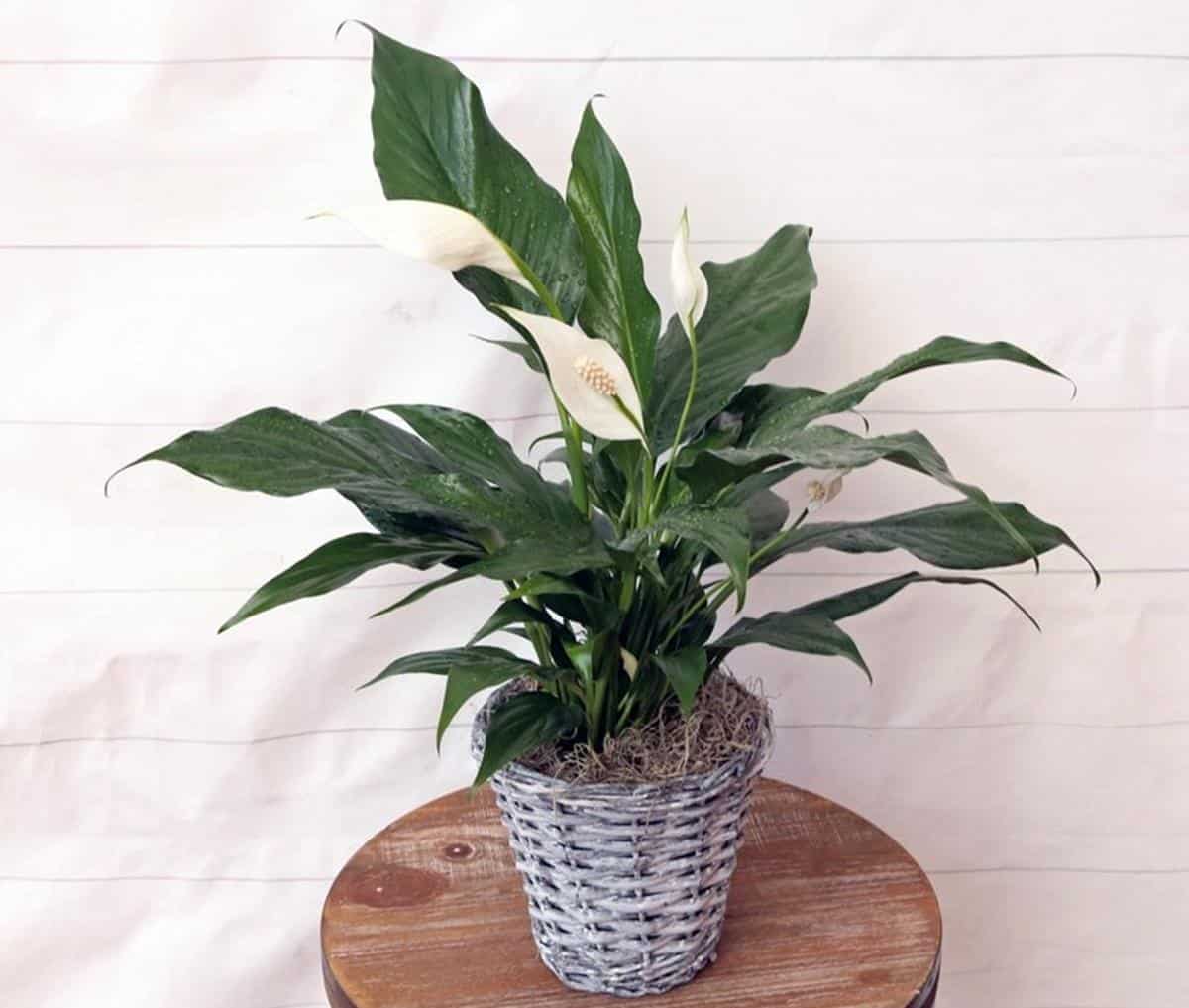The reasons for your peace lily leaves curling are underwatering, overwatering, low humidity, extreme temperatures, too much light, and overfeeding. However, nutritional deficiencies, pests, and transplant shock are also possible causes.
Depending on the cause, your Spathiphyllum ssp. or peace lilies may curl inward, under, or even downward. Also, it may occur with other symptoms like wilting or drooping, yellowing, browning or brown crispy tips and edges, etc.
We know it is not easy to know the exact cause. But with the symptoms we have for each possible reason, it will be much easier. You will also get a solution.

Contents
- Peace lily care and growth requirement
- Peace lily leaves curling causes, signs, and solutions
- 1. Underwatering and peace lily leaves curling
- 2. Overwatering and root rot
- 3. Low humidity
- 4. High temperature
- 5. Cold draft and chilly temperatures
- 6. Too much light
- 7. peace lily curling due to shock
- 8. Rootbound
- 9. Pests
- a. Thrips
- b. Mealybugs
- c. Spider mites
- d. Scale insects
- e. Aphids
- 10. Overfeeding
- 11. Nutritional deficiencies
- 12. Normal peace lily leaves curling
Peace lily care and growth requirement
Most reasons for peace lily leaves curling are due to improper care and wrong growing conditions. So, here are the basic growth requirements. They should quickly help you point out where you are missing it.
| Care level | Low or easy |
| USDA hardiness zone | 11 to 12 |
| Temperature | The ideal temperature range is 65-90°F (18-32 °C), but they can survive a range of 40-100°F (12-38 °C). |
| Humidity | They love humid areas, i.e., high humidity. But they won’t mind at least 50% |
| Light requirement | Can tolerate low light but prefer bright, indirect light. Avoid direct sunlight. |
| Best soil | Grow them in slightly acidic, pH 5.6 to 6.5, well-drained and high organic matter soil or potting mix |
| Watering | Please give Spathiphyllum constantly moist soils, i.e., not soggy or dry, and have medium water needs. Water them once the top inch of the soil feels dry. |
| Fertilizer | They don’t need much fertilizer. So, feed these plants once after one to two months when they are growing only. |
| Pruning and grooming | Trim diseased, dead, or damaged leaves closest to the stem and shower them occasionally to remove dust. |
| Repotting | Repot your peace lilies or divide them once every two years or rootbound. |
Peace lily leaves curling causes, signs, and solutions
Like other plants, peace lilies curl to prevent moisture loss or protect themselves from extreme conditions. Some of the common reasons include the following
1. Underwatering and peace lily leaves curling
Peace lily leaves curling inward is a sign they are thirsty or underwatered. They are trying to reduce their surface area to minimize water loss from leaves via transpiration.
Signs
A sure way to tell you your plants are thirsty is dry, pulled potting mix. Also, leaves will curl in, wilt or droop, have brown crispy edges or tips (leaf burn), turn yellow, and feel dry, less plump, and thinner. Also, your peace lily flowers may turn brown or have brown tips and margins
Solution
To confirm it is underwatering, feel the soil with your finger. Is it dry up to the first knuckle or not? If dry, your plant is thirsty.
Our preferred method is the use of a soil moisture meter. XLUX is our favorite brand. If the reading is 3 or less, it is time to water.
Once, you are certain your plants are thirsty, thoroughly and evenly watering your plant until excess flows from drainage holes. You can also use reverse bottom watering if you prefer it.
Next, check if the soil holds moisture, have the proper humidity and temperature, and set a reminder in case of neglect. But water these plants when the top inch of the soil feels dry.
2. Overwatering and root rot
Overwatering peace lilies will make the soil soggy. This will cut oxygen from the roots, making them not function well. So, they will not absorb water or nutrients well and will be weak.
That is not all. Waterlogged soil will favor soil bacteria and fungus growth, attacking the roots, causing root rot. Root rot will only worsen things and may kill your plant.
Signs
The soil will feel soggy even after not watering for a few days. Also, the low leaves will start yellowing and may curl downward from petiole to tip. Also, they will droop or wilt but won’t feel dry or improve with watering.
More signs are brown or black splotches, a mushy stem base, moldy and foul-smelling potting mix, wart-like brown, tan or white growths due to leaf edema, etc.
Solution
Hold watering, improve air circulation and ensure potting holes are draining Also, move your plant to a brighter place and maintain optimum temperature.
The other reason for overwatering is a poorly draining potting mix. Buy at aroid mix from Etsy.com or make yours at home.
Lastly, if your plant has root rot, repot it, cutting any brown or black roots with sterilized gardening scissors. Don’t forget to remove and discard the old potting mix.
3. Low humidity
Low humidity will increase water loss from leaves, and your potting mix will dry fast. In response, your peace lily leaves curl inward to prevent further moisture loss.
Signs
When humidity is low, the soil dries fast. Also, leaves will droop or wilt, have crispy brown margins or tips (leaf burn), and turn yellow.
Solution
Peace lilies prefer high humidity, at least 40% or more. If your hygrometer reads very low humidity, it may be the reason.
For those who don't have one yet, Govee Hygrometer Thermometer H5075 is our favorite. It has Bluetooth functionality and displays a 20-day curve graph. Also, it is accurate and has SMart APP alerts if humidity or temperature falls below or over set points.
To fix low humidity, mist plants a few times a week, or have a pebble tray. Also, you can move your plants to more humid rooms like bathrooms and kitchens or group them (creates a microclimate).
However, if the humidity is too low, you must buy a humidifier. AquaOasis™ Cool Mist Humidifier (amazon's best-seller) is an excellent brand. It is quiet, will run for a day without refill and has many other amazing features.
4. High temperature
High temperatures of like 90 degrees Fahrenheit (32°C) or more increase water loss, and your peace lilies will react by curling leaves inward, just as when they are thirsty.
Signs
Leaf scorch (browning, yellowing, having crispy brown tips and margins), curling, and wilting are typical signs you will notice. You will also feel the heat.
Solution
During hot summer days, move your plant to cooler places like a shade or room. Also, don’t place them near heat sources like heating system vents, fireplaces, radiators, etc. If you have an HVAC, turn it on.
5. Cold draft and chilly temperatures
Cold draft and chilly temperature cause peace lily leaves to curl, something unusual. A possible explanation is to protect the plant by preventing quick thawing that will damage it.
Signs
Leaves may turn white, yellow, black, or brown, some browning overnight and droop or wilt. Also, they will have a burnt look and may curl.
Solution
Temperatures below 40 degrees Fahrenheit (4.4°C) will damage your plant. So, move your plant away from draft or chilly places in winter to warmer, less drafty spots. If outdoors, move them inside when the temperature goes below 50°F (10°C).
6. Too much light
As understory plants in tropical rainforests, Spathiphyllum species get dappled light. Thus, too much light will make your peace lilies curl leaves.
Why? To either protect themselves from direct sunlight that may damage their cells or prevent water loss. Too much light makes transpiration goes higher to help keep the plant cool because plants convert excess light energy to heat energy.
Signs
Besides your peace lily leaves curling, they will look bleached or washed out, especially those that receive much light. Also, they may have brown spots and brown tips and edges. But they won’t fall easily.
Solution
Avoid direct sunlight if you grow your plants outside. A greenhouse or shade will work well. Inside your house, move your plants away from windows where they get direct sunlight or have blinds. The south-facing window is the most notorious.
7. peace lily curling due to shock
Peace lily leaves curing after repotting, transplanting, relocating, or receiving a new plant is nothing other than shock. They are yet to adjust to the change.
Signs
Plant shock will cause drooping or wilting, browning, and yellowing of leaves. Other signs are leaf scorching, falling, and so on.
Solution
Ensure you maintain ideal growing conditions and the soil is always moist but not soggy. When repotting or transplanting this plant, minimize root damage.
8. Rootbound
When rootbound, these plants will not have soil to grow into and will not have enough water or nutrients. Thus, they will curl leaves and show other signs.
Signs
Common signs are roots growing from drainage holes, leaves curling upward, yellowing, browning, drooping and wilting.
Solution
Here, the solution is repotting your peace lily. But only do if it is during the growing season. Otherwise, you will wait till late winter or early spring.
9. Pests
Does this have thrips, spider mites, scale insects, aphids, or mealybugs? They may be the reasons leaves curling, looking distorted and ruffled. These bugs suck plant juices depriving them of water and nutrients. Some inject toxins that curl, deform, ruffle or distort leaves.
a. Thrips
Thrips appear as tiny, yellowish to black, slender insects with fringed wings. They cause silvery stippling, leaf distortion, drop, and spots (brown, black or yellow). Hose your plant in a sink, use insecticidal soaps, dormant oil sprays, and horticultural oils.
b. Mealybugs
These small, soft-bodied pink or yellowish insects with powdery wax (grey or white) suck juices from leaves. Signs are honeydew, stunted growth, sooty mold, yellowing, falling, and curling of leaves.
To manage mealybugs, wipe leaves with cotton balls soaked in rubbing alcohol. Also, you can use neem oil, insecticidal soaps, or horticultural spray oils.
c. Spider mites
Spider mites appear as small, yellow to pale white oval moving dots. They will cause webbing, stippling, yellowing, curling, and leaf loss. Treat spider mites with miticides, insecticidal soaps, or horticultural spray oils.
d. Scale insects
These bugs appear as small, fluffy, or waxy bumps and will cause honeydew, sooty mold, leaf yellowing, and falling prematurely. Use water jet to knock them off, horticultural spray oils, or insecticidal soaps.
e. Aphids
Small, soft-bodied pear-shaped insects that may be green, red, black, yellow, gray, or brown, not readily visible with naked eyes. Signs of infestation include yellow leaves, young shoots and leaves wilting, stunted growth, distorted leaves (curled, misshapen or twisted), honeydew, and sooty mold.
Use a high-pressure jet to knock them off. Use a mild solution of dish soap or dust plants with flour. Also, you can use insecticidal soaps, horticultural oils, or pyrethrins.
To control pests, here are the products we have tried and found effective:
- Bonide Ready to Use Neem Oil
- Garden Safe Brand Insecticidal Soap Insect Killer
- Bonide All Seasons Horticultural and Dormant Spray Oil, Insecticide
10. Overfeeding
Overfeeding will increase soil salt deposits and burn roots, and may alter soil pH. These three will affect water and nutrient absorption, and salts may draw water from the plant. The curling occurs because your plants are thirsty.
That is not all. Too much nitrogen may cause claw leaves to curl down at the tip. Also, it may make your peace lily flower (spathe) turn greenish.
Signs
Besides curling, other signs are leaf burn, crusts of fertilizer on the potting mix, wilting, yellowing of lower leaves, and stunted growth.
Solution
Peace lilies don’t need much fertilizer. Apply fertilizer a few times a year during the growing season only. Use a balanced houseplant fertilizer.
11. Nutritional deficiencies
If your plants don’t get enough nutrients, i.e., your soil is low in organic matter, and you don’t feed them, leaves can curl down or upward.
Signs
Yellowing or chlorosis, including yellow spots, stunted growth, and brown leaf edges or scorched look, are common signs when they lack nutrients.
But deficiency of some nutrients may make peace lily leaves curl down or upward and appear deformed. For instance, a nitrogen deficiency, calcium may cause upward curling while magnesium will make leaves curl up along the margin.
On the other hand, a lack of phosphorous, calcium, and boron may make leaves curl downward.
Solution
Use a balanced fertilizer to feed your plants once or twice a year. Choose brands intended for potted or houseplants.
12. Normal peace lily leaves curling
Some varieties like Spathiphyllum’ Wallisii’ have puckered or rippled leaves that may look wrinkly. Consider this a usual appearance and not any curling.
Also, as leaves age, they may turn yellow, have brown patches and curl upward or even downward. Again, this is usual.





Marsha Bailey
My leaves are a beautiful rich green, it is pest free, but the leaves are curling downward into almost rolls, like the middle is too short almost and pulling the end of the leaf under. I don’t know how to post a photo, but it is VERY difficult to explain, and I don’t know much about house plants at all. I had fed it, maybe it was too concentrated for the plant, it was quite large, I also moved it, it did not thrive in its new home so I moved him back to his old home… please let me know if you have any ideas.
Editorial Team
From what you are suggesting, we feel it may be overfeeding. For instance, too much nitrogen or toxicity is known to make leaves curl or claw. Also, overwatering may make leaves curl downward from the tip to the leaf base. What fertilizers do you use and how often do you feed your peace lilies? For a more accurate diagnosis, we would wish to see the photos. Please, if possible send your image(s) to email us. We will publish it and let other people also share their ideas.